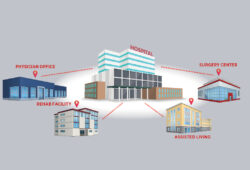How the journey to value-based care models have been affected by a global pandemic
When it was first introduced, value-based care (VBC) was considered to be a revolutionary force in the U.S. healthcare system. Designed to reward quality of care over quantity of care and the best care at the best price, the concept of value-based care has expanded to cover a wide continuum of models and alternative payment models (APMs) since its inception in 2008.

The massive impact of COVID-19 on the healthcare industry has certainly influenced the next phase of value-based care, with healthcare systems throughout the country focused on battling this crisis while under increasing financial stress. The pressure to reduce healthcare costs is likely to grow, says Kimberly Wright, RN, AVP of Clinical Services at HealthTrust. “In 2018, the U.S. was already spending $1.6 billion more on healthcare than what was in the budget,” she explains. “And then COVID-19 hit. Something’s going to have to change.”
The COVID-19 roadblock
Severe restrictions on elective procedures during the pandemic have meant a significant loss in income for many hospitals. This is compounded by higher costs from higher patient capacity and lengths of stay, and the higher demand for personal protective equipment, leaving hospitals in a challenging financial position.
On top of that is the uncertainty that has been a defining characteristic of the pandemic.

“You have no idea what the length of the illness is going to be, what the different manifestations of the illness are going to be, how that’s going to impact your outcomes and your total cost of care,” says HealthTrust Physician Advisor William Cloud, M.D., Chief Medical Officer at Baptist Memorial Hospital in Memphis, Tennessee. “Even if you had a robust way of dealing with care in the pre-pandemic model, it doesn’t apply to care in the pandemic model.”

The pandemic has reduced time and resources for non-COVID care, which has resulted in less time to fulfill the data requirements of value-based care programs, says Holly Moore, MSN, CCRN-K, Director of Clinical Services at HealthTrust. In addition, the reduction in non-COVID-19 procedures means less volume to measure for quality and costs, which could impact payments from value-based models and APMs. “The lower the volume, the more the outliers make an impact on those metrics needed to have a positive financial result,” says Moore.
Transitioning to value-based care can be challenging in the best of times. For hospitals without much experience in these models, a pandemic compounds the difficulty. Each model comes with its own requirements and learning curve, and the financial benefits may not be felt right away. “Providers get better incentives as they get more practiced at what’s required and get the processes in place. But that takes time,” says Moore.
Establishing detours
In response to the pandemic’s demands on hospitals, the Centers for Medicare & Medicaid Services (CMS) has made changes to its value-based care programs. These changes focus on financial methodologies, quality reporting and model timelines, and include extending data submission deadlines, excluding patient data and removing downside risk for providers. “They are trying to give providers a break to accommodate the hit that everybody has taken,” says Wright.
But CMS is not backing away from value-based care programs. In a May 2020 webinar hosted by America’s Physician Groups, Brad Smith, Director of the Center for Medicare and Medicaid Innovation (CMMI), said, “I think we’re only going to double down on our commitment to value-based care based on what we’ve seen in the public health emergency.”
CMS continues to roll out or expand mandatory and voluntary programs, though at a slower pace, and has ambitious goals for value-based care: 100% of Medicare providers and half of Medicaid and commercial contracts will be in value-based programs by 2025.
According to research from Coverys, that means an estimated trillion dollars of risk would be transferred to hospitals, health systems and physician practices.
Appreciating the journey
For Dr. Cloud and Baptist Memorial Hospital, the pandemic has brought opportunities along with its challenges. “It’s given us an urgency in redesigning care processes. There are things we’ve talked about doing, but during the pandemic, we’ve had to do them. We see that as a positive,” he says. “These are things that may have taken us two to three years to do without a pandemic.”

One opportunity, seen across the country, is the increased use of telemedicine. “In the past,” Dr. Cloud says, “there was a lot of talk about it, but the adoption of telemedicine was slow. However, during the pandemic, we absolutely had to deploy it.”
He shares that Baptist Memorial Hospital has implemented new staffing models, such as team-based care, to accommodate the challenge of staffing a hospital when some percentage of your team is furloughed due to COVID-19. The collaborative approach of team-based care is central to value-based care. “Historically, our healthcare industry has worked in a lot of silos,” Moore says. “Value-based programs force us to do a better job transitioning patients and making sure we’re partnering with post-hospital caregivers—whether it be home health or a skilled nursing facility.”
Baptist Memorial Hospital has also adopted new transitional care models, looking at, for example, how to discharge suitable patients early in order to increase capacity within the hospital. This included developing an outpatient oxygen-weaning program for COVID-19 patients, which led them to apply for the CMS Acute Hospital Care at Home program. “These moves signal an increased acceptance by the provider to deliver care that is less costly, but with the same expectation of quality,” says Dr. Cloud.
The road ahead
Dr. Cloud expects the innovations that have occurred during the pandemic to continue to improve healthcare. “By necessity, the pandemic created the rapid acceptance of technology that otherwise may not have occurred. And I think it will continue—maybe not to the degree it has during the pandemic, but it’s not going away,” he says.
The COVID-19 pandemic has created a renewed interest in the role these models can play in improving healthcare for Americans, and the journey continues. “I wonder how the way we talk about value-based care now will change compared to when we get on the other side of this pandemic,” says Dr. Cloud. “How are we going to view quality, safety and value differently than we did before?”
The transition to a value-based care model can be challenging and time-consuming. “The problem is, how do you go from a fee-for-service model, which 80% of hospitals still use, to a value-based care model?” says Wright. “Hospitals and health systems have to figure out how to make that safe transition.” She offers the following advice:
- Transition sooner rather than later (while taking the pandemic into account). CMS uses regional pricing in many models, meaning that as providers in your region join value-based programs, costs go down, making a later transition increasingly difficult.
- Understand your patient population. What are their needs, demographics and health histories? What resources do you have available to meet those needs?
- Know the numbers. Understanding how your prices and performance compare to other hospitals in your region is crucial.
Use risk-assessment tools to help mitigate patient risk and standardize care.
Learn more about VBC.






